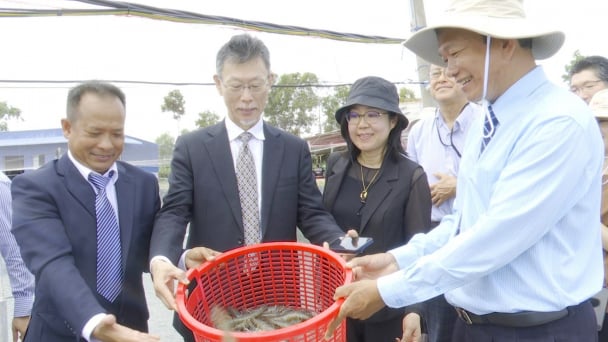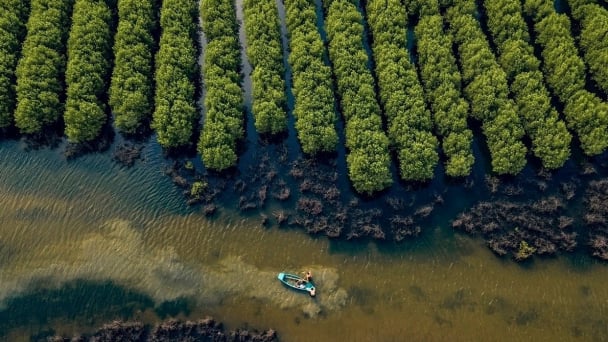June 17, 2025 | 07:27 GMT +7
June 17, 2025 | 07:27 GMT +7
Hotline: 0913.378.918
June 17, 2025 | 07:27 GMT +7
Hotline: 0913.378.918

According to the Animal Husbandry Association of Vietnam, domestic livestock production faces considerable challenges compared to other economic sectors, as well as the livestock sectors in developed countries. Photo: Hong Tham.
The Animal Husbandry Association of Vietnam recently submitted a document to the Ministry of Natural Resources and Environment to provide feedback on the amendments and additions to the Government's Decree No. 06/2022/ND-CP, which regulates greenhouse gas reduction and ozone layer protection. The document included a proposal to incorporate the livestock sector and facilities into the greenhouse gas inventory.
The Animal Husbandry Association of Vietnam asserted that reducing greenhouse gas emissions and protecting the ozone layer represents the government's comprehensive strategy to fulfill Vietnam's commitments to reduce greenhouse gas emissions and combat global climate change.
However, Vietnam possesses considerable potential for reducing greenhouse gas emissions compared to developed industrial countries. Accordingly, various industries can contribute to Vietnam's greenhouse gas reduction commitments; including mining, steel refining, construction, transportation, afforestation, rice production, among many others.
The aforementioned industries exhibit both significant potential and high profitability, complemented by various government support initiatives, such as afforestation programs or the "Sustainable Development Project for one million hectares of specialized, low-emission high-quality rice in association with green growth in the Mekong Delta region". Conversely, domestic livestock production faces considerable challenges compared to other economic sectors, as well as the livestock sectors in developed countries
Consequently, the incorporation of livestock facilities into the current greenhouse gas inventory is inadvisable and unfeasible. There is a notable lack of governmental support for a sector confronted with substantial risks in integration. Moreover, the majority of countries within Vietnam's International Free Trade Agreements, such as CPTPP, EVFTA, and the US-Vietnam agreement, possess significantly more favorable conditions and ample space for livestock development.
Mr. Nguyen Xuan Duong, Chairman of the Animal Husbandry Association of Vietnam, has highlighted several drawbacks if greenhouse gas inventory are immediately applied to livestock facilities, including increased production costs and increased prices for domestic livestock products, which are considerably higher compared to that of developed countries.
Every year, each livestock facility incurs expenses ranging from 100 to 150 million Vietnamese dong solely for inventory activities. Additionally, these establishments fall under the obligation to reduce greenhouse gas emissions on an yearly basis. Failure to comply with these requirements will result in penalization, thereby posing considerable challenges for livestock farmers and giving rise to unwarranted negative consequences.
On the other hand, Vietnam is currently managing a sizeable number of livestock facilities. With the exception of dairy farms and pig breeding farms managed directly by businesses equipped with proficient managerial and technical personnel capable of executing inventory procedures and enforcing greenhouse gas emission reduction measures, a significant portion of Vietnamese livestock farms fail to meet these requirements.
Based on the experience that TH Group accumulated over the past four years, the first two years of implementing greenhouse gas inventory activities can be extremely challenging, despite significant investment and direct guidance from foreign experts.
Furthermore, the current availability of domestic service organizations and experts with the necessary qualifications and experience to guide inventory activities and implement greenhouse gas control measures in the livestock sectorr is limited. Consequently, additional time investment for training activities is necessary.

At present, it is not advisable for Vietnam to incorporate the livestock sector and facilities into the greenhouse gas inventory. Photo: Hong Tham.
For these reasons, the Animal Husbandry Association of Vietnam proposed the Ministry of Natural Resources and Environment to refrain from incorporating the livestock sector and facilities into the greenhouse gas inventory. This exclusion, extending until 2027 at minimum, allow management agencies, service providers, and livestock farmers additional time and resources to acclimate, acquire relevant knowledge, and adopt suitable technologies. This extension period also facilitates the renovation of facilities and the accumulation of resources necessary to effectively address these novel and complex challenges.
According to the Animal Husbandry Association of Vietnam, despite previous intentions to contribute to national emission control goals, a thorough examination of the situation reveals that the incorporation of the livestock sector and facilities in the greenhouse gas inventory is currently unfeasible. This conclusion is drawn from on-site surveys; consultation workshops involving experts, businesses, and livestock farmers; and extensive research of insights from other countries.
In contrast to the stance of the Animal Husbandry Association of Vietnam, the Department of Livestock Production under the Ministry of Agriculture and Rural Development contended that, in accordance with the government's directives on greenhouse gas reduction targets and strategies, Vietnam must implement a framework for managing greenhouse gas emission data from livestock facilities. This framework can be established based on data provided by the Ministry. Furthermore, large-scale livestock facilities are recommended to promptly initiate greenhouse gas inventory activities. Notably, several major businesses have completed the preliminary stages of this inventory process.
This process complies with the IPCC's requirements for greenhouse gas inventory activities, wherein the livestock sector holds a significant portion of national greenhouse gas emissions. Large-scale livestock facilities are required to provide data or prepare inventory reports depending on each country's management approach and data management system for greenhouse gas emissions.
With greenhouse gas emission inventory reports, businesses will gain insights into opportunities for reducing emissions throughout their production processes.
Translated by Nguyen Hai Long
![Turning wind and rain into action: [4] Bringing climate bulletins to remote and isolated areas](https://t.ex-cdn.com/nongnghiepmoitruong.vn/608w/files/linhnhp/2025/06/14/1152-z6704423696987_15fd32ffc26d590d204d520c9dac6786-nongnghiep-151141.jpg)
(VAN) The Vietnam Agriculture and Nature Newspaper interviewed Mr. Vu Thai Truong, Acting Head of Climate Change and Environment at UNDP Vietnam, to gain deeper insight into how climate bulletins are delivered to farmers.

(VAN) In Tien Giang, a high-tech shrimp farm has developed a distinctive energy-saving farming model that has yielded promising results.
![Turning wind and rain into action: [3] 300.000 farmers benefit from agro-climatic bulletins](https://t.ex-cdn.com/nongnghiepmoitruong.vn/608w/files/news/2025/06/12/e5a48259d6a262fc3bb3-nongnghiep-125122.jpg)
(VAN) The agro-climatic bulletin has become a valuable tool for farmers in the Mekong Delta. After more than five years of implementation, the initiative is gradually being expanded nationwide.
![Turning wind and rain into action: [2] Providing forecasts to the people](https://t.ex-cdn.com/nongnghiepmoitruong.vn/608w/files/news/2025/06/12/e5a48259d6a262fc3bb3-nongnghiep-103927.jpg)
(VAN) In addition to improving the quality of hydrometeorological forecasts, putting forecast bulletins into practical use is crucial for production and disaster prevention.

(VAN) Blue carbon is receiving attention for its rapid absorption capacity and vast potential. It represents a promising nature-based solution to respond to climate change.
/2025/06/11/3507-1-161904_583.jpg)
(VAN) Seagrass beds and coral reefs serve as 'cradles' that nurture life in the ocean depths, creating rich aquatic resources in Vietnamese waters.
![Turning wind and rain into action: [1] Forecasting for farmers](https://t.ex-cdn.com/nongnghiepmoitruong.vn/608w/files/news/2025/06/11/e5a48259d6a262fc3bb3-nongnghiep-111919.jpg)
(VAN) Weather is no longer just a matter of fate. Forecasts have now become an essential companion for farmers in every crop season.